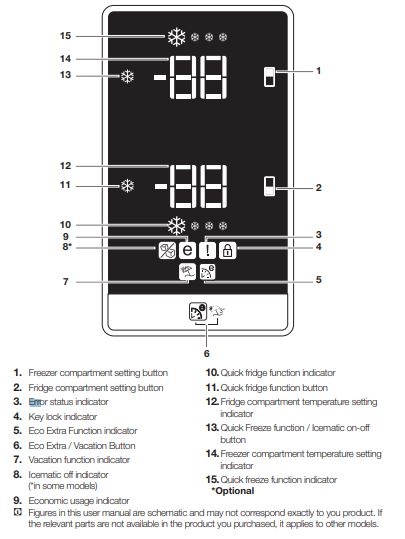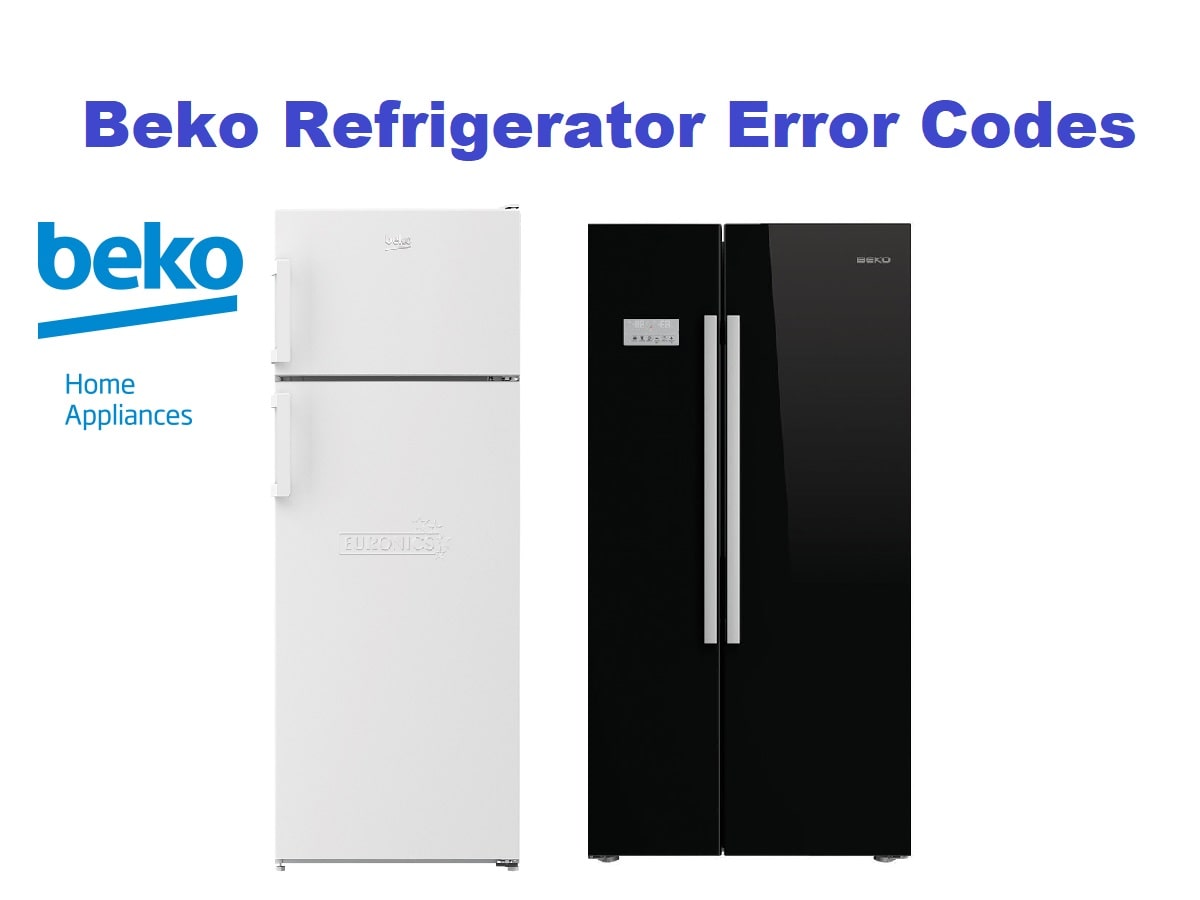Rather than just an appliance, the fridges became a decoration purpose. A pilling agent, that drives you to the kitchen and captivates you with features such as French doors, a bottom freezer, built-in refrigerators, and so on. A dream come true for those looking to add more charm and character to their kitchens.
Refrigerators take on the major load of your kitchen, which is why you need them up and running smoothly at all times. Unfortunately, there are times when the system comes crashing down, but there are some fixes you can take on your own. Start by noting down the error code, and match it using the list below. Once you have the error code you can easily work your way to the fix. To help you out we have listed down some of the most common error codes for the Beko refrigerator.
American SBS Fridge Freezer
| Error Codes | Problem |
|---|---|
| E0 | Freezer sensor failure |
| E1 | Freezer defrost sensor failure |
| E3 | Fridge sensor failure |
| E4 | Defrost heater failure |
| E8 | Ice sensor failure |
| E9 | Ice machine failure |
If your refrigerator does not cool adequately or if there is a sensor failure, this indicator will be activated. When this indicator is active, Freezer Compartment Temperature indicator will display “e” and Fridge Compartment Temperature Indicator will display numbers such as “1,2,3…”. These numbers on the indicator provide information about the error to the service personnel.
| Error Codes | Solution |
|---|---|
| 2 | Cooling fault. Refrigerant leakage, compressor malfunction, fan failure in the refrigerator, improper sensor operation, open long door time. |
| 3 | Heater fault. The heaters do not work or do not work at full capacity, the refrigerator sensor must be repaired. |
| 4 | The sensor circuit is open. One of the sensors is not installed in place, a defect in the wires, a bad contact on the connectors. |
| 5 | Sensor short-circuit. Malfunction of the sensor, defect of the wires connecting one of the 3 temperature sensors with the control board, poor contact in the connectors. |
| 6 | The button is pressed. Faulty buttons, dirty buttons. |
| 7 | Malfunction of the compressor. Compressor does not work, refrigerant leaks, blockage of the circulation system. |
| 12 | Switch circuit fault. Bad contact on the switch, in the places of connecting wires to the control board or switch, high resistance of the wires. |
Troubleshooting

Recommended solutions for the problems
Please review this list before calling the service. It might save you time and money. This list includes frequent complaints that are not arising from defective workmanship or material usage. Some of the features described here may not exist in your product.
Problem: The refrigerator does not operate.
Solution:
- Is the refrigerator properly plugged in? Insert the plug to the wall socket.
- Is the fuse of the socket which your refrigerator is connected to or the main fuse blown out? Check the fuse.
Problem: Condensation on the side wall of the fridge compartment (MULTIZONE, COOL CONTROL and FLEXI ZONE).
Solution:
- Very cold ambient conditions. Frequent opening and closing of the door. Highly humid ambient conditions. Storage of food containing liquid in open containers. Leaving the door ajar. Switching the thermostat to a colder degree.
- Decreasing the time the door left open or using it less frequently.
- Covering the food stored in open containers with a suitable material.
- Wipe the condensation using a dry cloth and check if it persists
Problem: Compressor is not running.
Solution:
- Protective thermic of the compressor will blow out during sudden power failures or plugout plug-ins as the refrigerant pressure in the cooling system of the refrigerator has not been balanced yet. Your refrigerator will start running approximately after 6 minutes. Please call the service if the refrigerator does not startup at the end of this period.
- The fridge is in defrost cycle. This is normal for a full-automatically defrosting refrigerator. Defrosting cycle occurs periodically.
- Your refrigerator is not plugged into the socket. Make sure that the plug is properly fit into the socket.
- Are the temperature adjustments correctly made?
- Power might be cut off.
Problem: The fridge is running frequently or for a long time.
Solution:
- Your new product may be wider than the previous one. This is quite normal. Large refrigerators operate for a longer period of time.
- The ambient room temperature may be high. This is quite normal.
- The refrigerator might have been plugged in recently or might have been loaded with food. Cooling down of the refrigerator completely may last for a couple of hours longer.
- Large amounts of hot food might have been put in the refrigerator recently. Hot food causes longer running of the refrigerator until they reach the safe storage temperature.
- Doors might have been opened frequently or left ajar for a long time. The warm air that has entered into the refrigerator causes the refrigerator to run for longer periods. Open the doors less frequently.
- Freezer or fridge compartment door might have been left ajar. Check if the doors are tightly closed.
- The refrigerator is adjusted to a very low temperature. Adjust the refrigerator temperature to a warmer degree and wait until the temperature is achieved.
- Door seal of the fridge or freezer may be soiled, worn out, broken or not properly seated. Clean or replace the seal. Damaged/broken seal causes the refrigerator to run for a longer period of time in order to maintain the current temperature
Problem: Freezer temperature is very low while the fridge temperature is sufficient.
Solution: The freezer temperature is adjusted to a very low temperature. Adjust the freezer temperature to a warmer degree and check.
Problem: Fridge temperature is very low while the freezer temperature is sufficient.
Solution: The fridge temperature might have been adjusted to a very low temperature. Adjust the fridge temperature to a warmer degree and check.
Problem: Food kept in the fridge compartment drawers are freezing.
Solution: The fridge temperature might have been adjusted to a very low temperature. Adjust the fridge temperature to a warmer degree and check
Problem: Temperature in the fridge or freezer is very high.
Solution:
- The fridge temperature might have been adjusted to a very high degree. Fridge adjustment has an effect on the temperature of the freezer. Change the temperature of the fridge or freezer until the fridge or freezer temperature reaches to a sufficient level.
- Doors might have been opened frequently or left ajar for a long time; open them less frequently.
- Door might have been left ajar; close the door completely.
- Large amount of hot food might have been put in the refrigerator recently. Wait until the fridge or freezer reaches the desired temperature.
- The refrigerator might have been plugged in recently. Cooling down of the refrigerator completely takes time.
Problem: The operation noise increases when the refrigerator is running.
Solution:
- The operating performance of the refrigerator may change due to the changes in the ambient temperature. It is normal and not a fault.
- The floor is not even or it is weak. The refrigerator rocks when moved slowly. Make sure that the floor is strong enough to carry the refrigerator, and level.
- The noise may be caused by the items put onto the refrigerator. Items on top of the refrigerator should be removed.

Problem: There are noises coming from the refrigerator like liquid spilling or spraying.
Solution: Liquid and gas flows happen in accordance with the operating principles of your refrigerator. It is normal and not a fault.
Problem: There is a noise like wind blowing.
Solution: Fans are used in order to cool the refrigerator. It is normal and not a fault.
Problem: Condensation on the inner walls of refrigerator.
Solution:
- Hot and humid weather increases icing and condensation. It is normal and not a fault.
- Doors might have been left ajar; make sure that the doors are closed fully.
- Doors might have been opened frequently or left ajar for a long time; open them less frequently
Problem: Humidity occurs on the outside of the refrigerator or between the doors.
Solution: There might be humidity in the air; this is quite normal in humid weather. When the humidity is less, condensation will disappear
Problem: Bad odour inside the refrigerator.
Solution:
- Inside of the refrigerator must be cleaned. Clean the inside of the refrigerator with a sponge, lukewarm water or carbonated water.
- Some containers or package materials might cause the smell. Use a different container or different brand packaging material.
Problem: The door is not closing.
Solution:
- Food packages may prevent the door’s closing. Replace the packages that are obstructing the door.
- The refrigerator is not completely upright on the floor and rocking when slightly moved.
- Adjust the elevation screws.
- The floor is not level or strong. Make sure that the floor is level and capable to carry the refrigerator.
Problem: Crispers are stuck.
Solution: The food might be touching the ceiling of the drawer. Rearrange food in the drawer.
Beko, established in 1955 is a Turkish appliance and consumer electronics company that is run by Koc Holdings. While offering a wide range of products the company soon began to focus on refrigerators. Offering the picture of a healthier lifestyle, where your fringe is the centerpiece.

